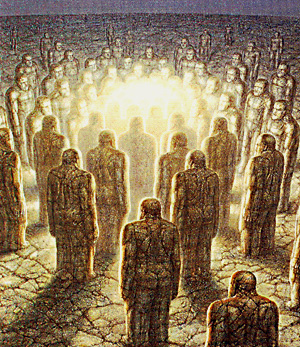|
|
MANIFESTO OF VISIONARY ART
|
Or, as Robert Venosa puts it "...to translate in form and color the roadmap to the source and center of our being and to the heart of our Divine Creator."(35)
Or again, in the words of Blake:"To open the Eternal Worlds, to open the immortal Eyes."(36)
This is second nature to most Visionary artists. They do not question what they do. It comes naturally, as a part of their being."The artist," Fuchs attests, "is commanded by nature - when we consider him, as the Old Masters certainly did, to be born to such an office - to make the invisible world visible, much like the ancient ascetics who, through their uninterrupted prayers, brought about the immersion of the Eternal God into Man's temporally finite world." (37)
The manner in which the Visionary artist evokes the Sacred may differ from painter to painter. In fact, it may differ from one painting to another within one artist's oeuvre. What matters is the underlying vision. In the case of many artists, this is a vision of Unity: the Sacred presents itself as the hidden but solitary source behind all things. It is an experience of shared oneness - difficult to describe in words alone, and often finding outlet instead in images.
For example, De Es writes:"This artist's epiphany completely prevented me from focusing on a single canvas, but drove me to work on a sequence of paintings in order to satisfy my sense of 'wholeness.' All the universal themes of the yearnings of the human heart for enlightenment should be integrated into it: the journey to the light, the dance of joy, goals, ideals, and pathways to the beyond and to the light of life. ...The wild dynamism of my transformative method was nurtured by the vision of 'Humanity awakening as a oneness.'" (38)
|
|
|
|
|

DE ES: VISION ONE (Detail)
From the triptych THE JOINING
|
It is for this reason that many of his 'stone men' became increasingly aware of and transparent to... 'light'. They became 'heavy light'. And finally, in the crowning image of his triptych 'The Joining', they became a many-circled gathering around one light - a panel which the artist called 'White Light' or 'Vision One'.
|
|
|
|
